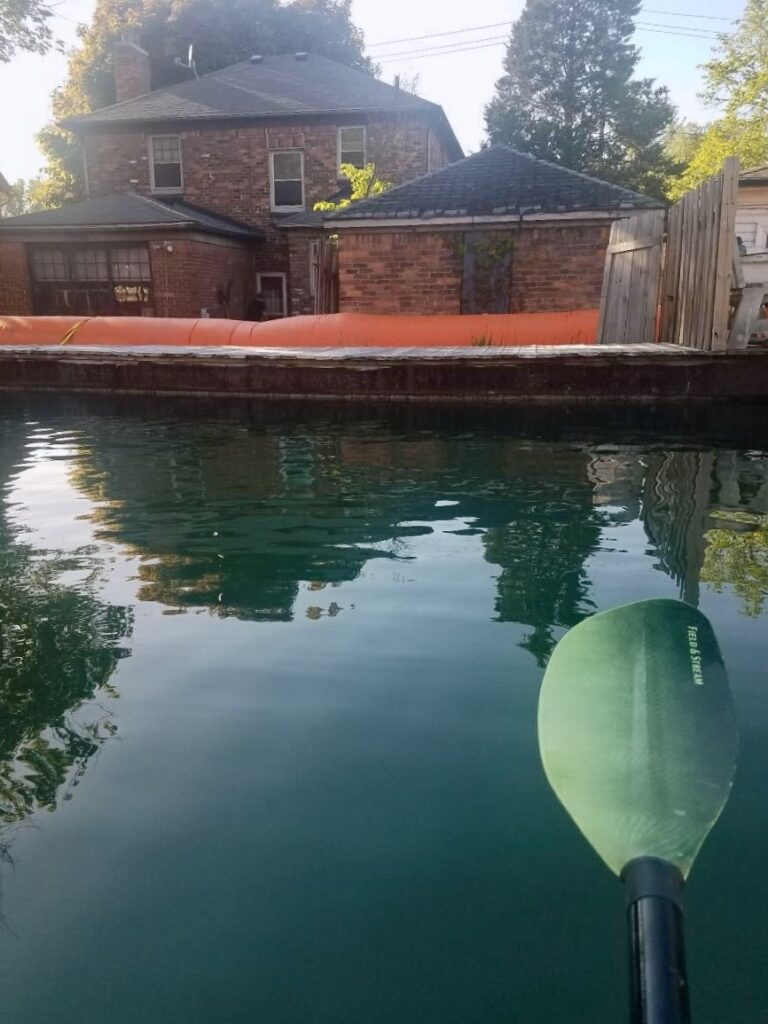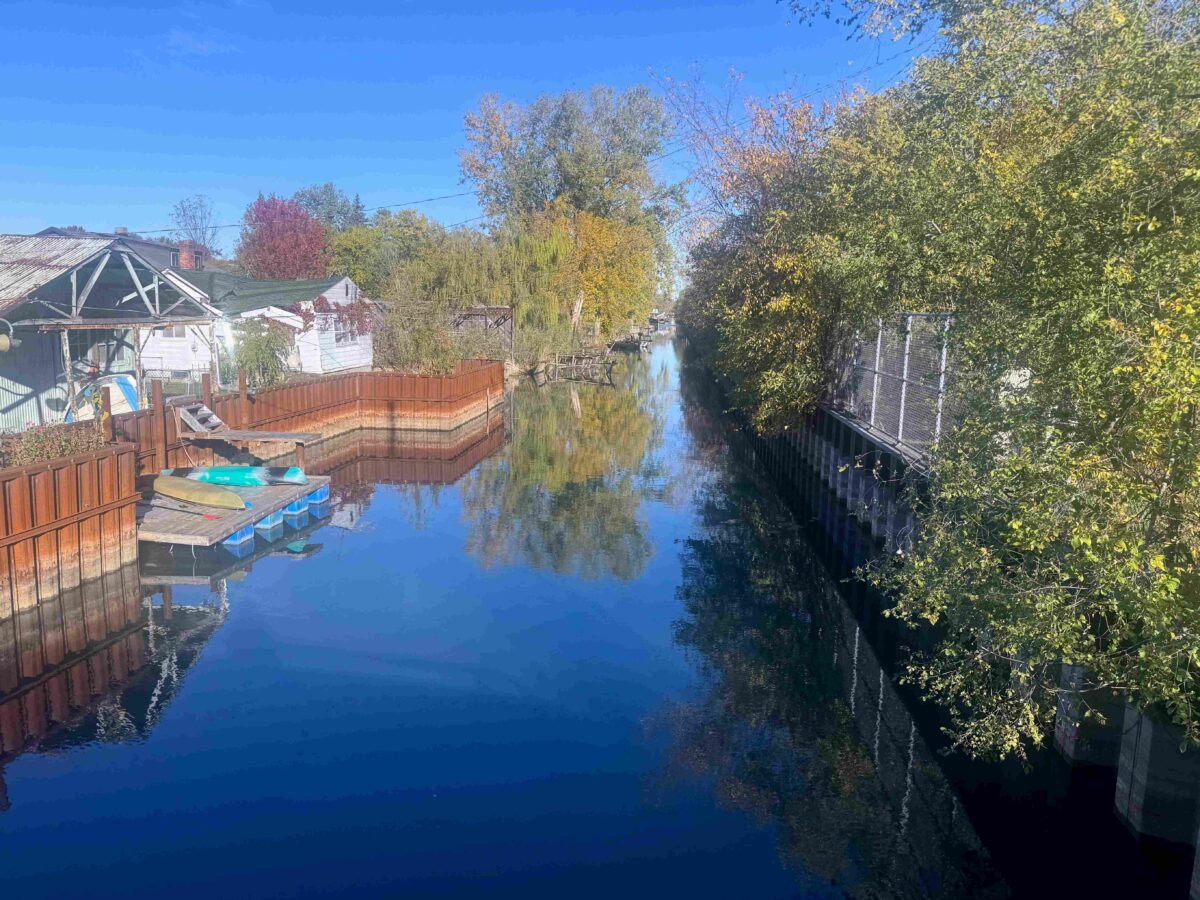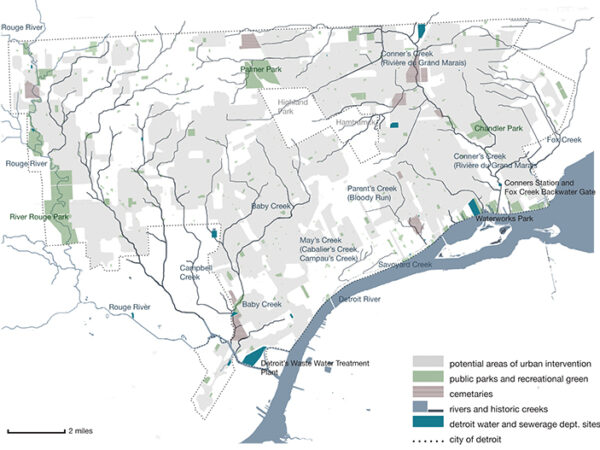Overview:
- Residents are surveying seawall conditions at properties along Fox Creek in Detroit's Jefferson Chalmers neighborhood.
- Reinforced seawalls would remove the neighborhood from a FEMA flood hazard area, according to an Army Corps study.
- Councilmember Latisha Johnson is working to get applications for a seawall grant program out to the public by spring.
In the canal community of Harbor Island, tucked inside Detroit’s Jefferson Chalmers neighborhood, Dan Piepszowski makes a concerted effort to enjoy his year-round Detroit River access.
“We boat, we fish, we kayak, we paddleboard — we try to take full advantage of all the beautiful assets here, and we know we’re privileged to have access to these,” he said.
Yet in years of sewage backups and river water runoffs, Piepszowski and other residents who live along the Fox Creek canal have encountered the flipside of waterfront property ownership.
In 2021, the Federal Emergency Management Authority placed Jefferson Chalmers in a flood hazard designation, requiring homeowners with mortgages to buy expensive flood insurance, and regulating new construction and development.
Four years later, the designation has brought higher insurance costs and restrictions on federally funded home repairs and projects. As frustration builds over a comprehensive solution, some community advocates say they have a solution to assist the neighborhood in escaping FEMA’s flood zone regulations.
This fall, community organizers are working in tandem with city officials to draw up a city grant program that could assist low-income Jefferson Chalmers property owners with covering the costs of repairing and improving their seawalls, oftentimes the first line of defense for homes and basements during heavy rain events.
The shoreline resilience grant, which would be funded with $1 million in state dollars earmarked for Jefferson Chalmers, is seen by some residents as the least disruptive route to protecting the neighborhood from future flooding and preserving its identity.
A neighborhood submerged
For at least half a century, proposals from local residents and federal agencies like the U.S. Army Corps of Engineers aimed to address flooding in Jefferson Chalmers.
The ideas include installing floodgates at the openings of the neighborhood’s canals, special tax assessments to maintain seawalls, or negotiating joint infrastructure projects with neighboring Grosse Pointe Park.
In recent years, the city installed orange “tiger dams” as an attempt to control floodwater, but most solutions have been temporary or insufficient, according to longtime residents.
“There’s a series of decisions and implementations that the city has made that haven’t panned out or made sense and are a total waste of money,” said John Myers, a 30-year Jefferson Chalmers resident.
“Building dams and walls and all that other stuff are great, but they don’t necessarily find a total solution,” he said. “We’ve been begging them to put in a storm drain and have a separate storm and sewage system.”
In 2022, the U.S. Army Corps of Engineers published a study of long-term flood mitigation strategies for Jefferson Chalmers, proposing three recommendations for how the city could reduce property damage and health hazards across the neighborhood.
That same year, overwhelming community opposition stopped the city from moving forward with the Corps’ recommendation to close the canals.
“We felt that the stop log scenario just wasn’t really well thought out, and did not embody the focus that we think that this neighborhood deserves,” said Piepszowski.
“It’s such a unique neighborhood, and there’s a lot of work that needs to be done to come up with a fix that is equitable.”
Residents aim to remove FEMA flood designation
Since mid-October, Piepszowski and a crew of residents have surveyed properties along Fox Creek, jotting down notes of the conditions of seawalls that wrap around the canal.
By the time the survey is complete, the community will have a better picture of what types of improvements are needed, Piepszowski said. Some properties only have partial seawalls, while others lack them completely, he said.
“We’ll have a better understanding of potential sites that could use a more graded riprap,” he said, referring to material added to protect seawalls.
“Where there’s no seawall, or there’s partial seawall, and where it may be just more cost efficient to tear out the partial seawall and then work toward a riprap solution.”
The seawall documentation is organized by Jefferson Chalmers WATER Project, a group of residents “working to find resilient and sustainable solutions to water resource and climate challenges in our community.”
“There’s nobody that knows more about the water and the safety and the issues around flooding than the people living in our neighborhood,” said Jay Juergensen, a Jefferson Chalmers resident and founder of the WATER Project. “They’re the experts. They should be at the table.”
While public outcry halted the city’s canal closure, the WATER Project is now drumming up community support and public funding for the Corps’ third recommendation: keeping the canals open by strengthening the neighborhood’s shoreline with reinforced seawalls.
The plan “would allow the canals to remain open to the public” and would “remove the Jefferson-Chalmers neighborhood from the FEMA Flood Hazard Area,” according to the 2022 Army Corps study.
Juergensen, who also functions as a technical expert for the WATER Project, estimates that a comprehensive repair and improvement of the neighborhood’s seawalls would cost around $11 million.
The $1 million shoreline resilience grant is a means to demonstrate how a larger scale project will address seawall disrepair around the neighborhood, he said.
The Army Corps recommendation, which has an estimated cost of $88 million, would result in “limited direct water access for individual homeowners due to the height of the new wall.”
Seawall construction and maintenance are often considered a private homeowner problem, Juergensen said. He and some other residents argue they should be recognized as a public health and safety issue.
Wealthier Michigan cities, he argues, have not only allocated local dollars toward flood mitigation, but received larger sums of state funding as well.
In the 2026 state budget, tens of millions of dollars are set aside for local flood infrastructure projects, including $10 million for flood mitigation projects in Midland and $1 million for seawall repair in Grosse Pointe Farms.
‘No regulatory framework’ for canals: Jefferson Chalmers resident
Detroit City Councilmember Latisha Johnson represents District 4, which includes Jefferson Chalmers. She’s working with residents to get applications for the seawall grant program out to the public by spring, she told Planet Detroit.
Johnson said she supports seawall repair and construction as a step toward getting the neighborhood’s FEMA flood zone designation dropped.
The entire neighborhood, including properties that are not on the shoreline, is in a floodplain due to factors like the shoreline elevation and interior drainage, she said.
Federal grant dollars are restricted as a result, Johnson said, particularly in cases of home repairs.
Other efforts to improve the neighborhood’s water infrastructure are on hold, such as an $11.3 million federal grant to enlarge sewers in Jefferson Chalmers.
The grant, offered through FEMA’s Building Resilient Infrastructure and Communities program, is on pause after the Trump administration cut funding to the program in April.
Johnson said to her knowledge, FEMA “have not rescinded any dollars as of yet,” and she’s looking to speak with the city’s Water and Sewage Department to see if it can earmark the dollars before they are no longer usable.
As it stands, residential efforts to improve seawalls are not overseen by any city authority, and property owners have limited incentive to improve their seawalls.
Johnson said the seawalls that wrap around the Fox Creek canal are in various states of disrepair. Last year, her staff identified at least 19 properties whose owners need financial assistance to build their seawalls.
“We do recognize that there are some properties that are inherited by family members and perhaps they didn’t recognize that the seawall was their responsibility to maintain,” she said, adding that city-owned parcels have lacked upkeep as well.
“I would venture to say some have not been touched in years.”
Longtime residents say the cost of maintenance often exceeds what residents can afford, particularly older adults on fixed income, and a lack of city guidance has only confused and frustrated them.
“It’s a ridiculous amount of money to get these seawalls done,” said resident Blake Grannum, who was quoted $25,000 in 2023 to repair her wall. Other canal residents have spent upward of $50,000.
“There’s only a certain number of companies that actually do it, so most of the companies are already backed up and then they put you on a waiting list.”

The city of Detroit, while it does enforce compliance for existing seawalls, does not issue permits for building or replacing them, according to city spokesperson John Roach.
“In those cases, the individual homeowners and their contractor must obtain a proper permit from EGLE/USACE and refer to their guidance and any specific requirements,” Roach said via email.
In 2022, the Detroit City Council approved the Detroit River Protection Ordinance, which said that commercial properties along the riverfront must register their buildings and undergo regular inspections of their seawalls and other shoreline barriers.
“We’re working in an environment that has no regulatory framework,” said Juergensen. “You go a couple of miles up the street and St. Clair Shores has a regimented process to address their shoreline. They have a specific application that sets the height. They have a process for how they do inspections.”
City officials have said as recently as 2023 they would fine or sue residents who fail to maintain or build their seawalls, but have shied away from doing so until seawalls on city-owned properties are repaired.
🗳️ Civic next steps: How you can get involved
Why it matters
⚡ The Jefferson Chalmers neighborhood on Detroit’s far east side has experienced street flooding and basement backups due to sewage overflow and runoff from Detroit River canals. Residents have long advocated for a comprehensive infrastructure solution to reduce flood damage and health hazards.
Some advocates say seawall repair and maintenance along the canals and waterfront would reduce flood damage, and assist the neighborhood in getting removed from a FEMA flood zone designation that imposes restrictions on neighborhood development and home repairs.
Who’s making civic decisions
🏛️ The city of Detroit and Federal Emergency Management Agency,
How to take civic action now
- 🌱 Follow Jefferson Chalmers WATER Project on its website for updates and upcoming meeting dates.
- 📩 Email Councilmember Latisha Johnson for questions about the status of the Jefferson Chalmers Shoreline Resilience Program at councilmemberjohnson@detroitmi.gov.
- 📣 Ask city officials how they intend to address infrastructure issues in Jefferson Chalmers.
What to watch for next
🗓️ An application for the grant program is expected to go live in the spring, with construction projected for the summer, according to Councilmember Johnson.
Civic impact
🌍 Following and weighing in on flood control solutions in Jefferson Chalmers could shape the future of a Detroit neighborhood greatly affected by climate change and infrastructure shortcomings.
⭐ Please let us know what action you took or if you have any additional questions. Please send a quick email to connect@planetdetroit.org.
MORE PLANET DETROIT REPORTING
House bill would expand FEMA coverage for flooded, moldy Michigan basements: ‘There needs to be some equity’
“It is so bizarre as a member of Congress, finding out that FEMA will come and cover getting a new furnace or water heater, but won’t actually cover the actual mitigation and cleaning up of the sewage and the water in people’s basements,” says U.S. Rep. Rashida Tlaib.
Detroit’s ghost streams: Maps of hidden waterways combat city’s flooding problem
This story was produced in collaboration with the Detroit River Story Lab, a University of Michigan initiative that supports local efforts to center the river as a site of connection and belonging. The Lab’s local journalism portfolio includes the Detroit River Stories podcast series, the 100 Years Ago Today blog, and the Detroit River Beat, a collection of student-authored…
‘I’m still not on board’: Can GLWA’s new pump station design win over Jefferson Chalmers?
The Great Lakes Water Authority’s proposal for a five-story pump station in Detroit’s Jefferson Chalmers neighborhood, designed to blend with nearby structures, faces opposition from residents calling for better community engagement and information sharing.





